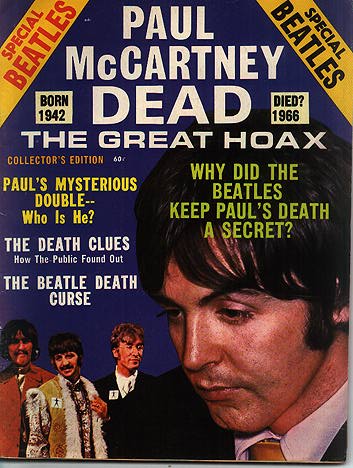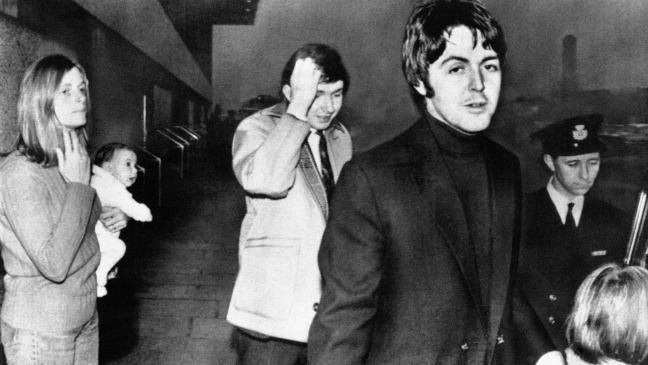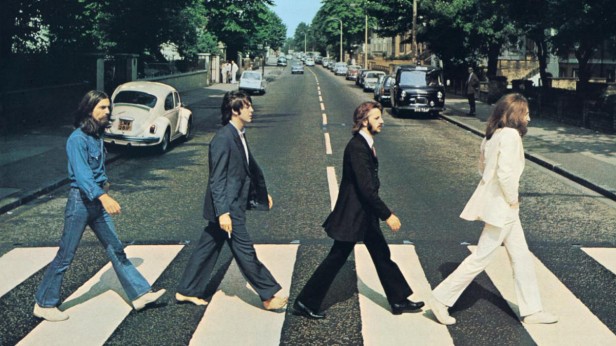
home.bt.com
October 22, 1969: Beatle Paul McCartney denies rumours of his own death
Paul McCartney denied that he had died in a 1966 car crash - rumours fuelled by 'clues' on the cover of the Abbey Road LP - in an interview with the BBC.
By Chas Early
Last updated: 22 October 2015

Beatle Paul McCartney gave one of the most bizarre interviews of his life on this day in 1969 when he appeared on the BBC to deny rumours that he had died three years earlier.
The 'Paul is Dead' myth, which claimed the musician had been killed in a car crash in 1966 and been replaced in the band by a lookalike, first surfaced in a university newspaper in the United States in September, before being picked up by a number of radio stations.
The rumour-mongers claimed that clues left by the Beatles in their songs and on their album covers revealed the truth. In fact, they claimed that the photograph gracing the sleeve of the band’s latest LP Abbey Road (below) provided the biggest hints yet.

The image was claimed to show a funeral procession, with John Lennon dressed all in white as a priest, Ringo Starr in a black suit as undertaker; McCartney (the ‘corpse’) barefoot, eyes closed and out of step with the others; and the denim-clad George Harrison as gravedigger.
Furthermore, a Volkswagen Beetle car in the background has the number plate LMW 28IF. 28IF was interpreted as referring to McCartney’s age, if he had lived. However, at the time of the album’s release he would actually have been 27.
The bass player had issued a statement from his Scottish farm in an attempt to quash the story.
"Rumours of my death have been greatly exaggerated," he said, paraphrasing Mark Twain. "However, if I was dead, I'm sure I'd be the last to know."
The statement did little to quell the intrigue, so McCartney had to invite the BBC’s Chris Drake to interview him on the farm. He blamed the rumour on the lower profile he had adopted since getting married to Linda Eastman and becoming a father for the first time.
The rumour eventually faded, but not before several songs recorded as ‘tributes’ to McCartney were released and became minor hits – and Capitol Records reported a big surge in the sales of Beatles records.
Do you remember the ‘Paul is Dead’ rumours? How much credence were they given at the time? Let us know in the Comments section below.
The 'Paul is Dead' rumours – Did you know?
· Initial false reports of McCartney’s death circulated in the UK in 1967, perhaps as a result of two occurrences; in the first, the musician crashed his moped, resulting in a chipped front tooth and a small scar on his top lip, which he had disguised by growing a moustache.

· The second incident was when McCartney’s Mini Cooper was written off in an accident on the M1 in January 1967 – but it was being driven at the time by Mohammed Hadjij, assistant to art gallery owner Robert Fraser, a close friend of the Beatle.

·The rumour grew courtesy of an article written by student Tim Harper which appeared in the Times-Delphic, the newspaper of the Drake University in Iowa.

· It gained momentum on October 12 after an on-air call to Russ Gibb, a Michigan DJ, in which the caller stated McCartney was dead, and claimed clues could be found on Beatle albums - sending fans rushing to their record decks to check.
· One of the stories claimed that the man who had replaced Paul in the band was one William Shears Campbell – the ‘Billy Shears’ who is introduced to listeners at the start of With a Little Help From My Friends on the Sgt Pepper album.
· So-called clues also included Lennon mumbling "cranberry sauce" at the end of Strawberry Fields Forever, misheard as "I buried Paul", and similarly his murmuring in I’m So Tired, interpreted as "Paul is dead, man, miss him, miss him".
· By the end of October, McCartney tribute records released included The Ballad of Paul by the Mystery Tour, Brother Paul by Billy Shears and the All Americans, and So Long Paul by Werbley Finster (a disguised José Feliciano), while Terry Knight’s Saint Paul was re-released.
· McCartney parodied the rumours with the title and cover of his 1993 album Paul Is Live. The artwork was based on the Abbey Road cover photograph; instead of the 28IF number plate, a car shows 51 IS instead.


No hay comentarios:
Publicar un comentario